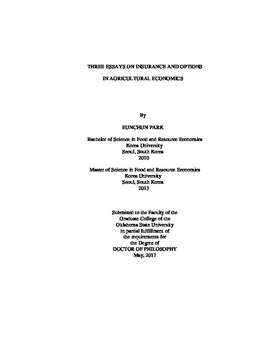| dc.contributor.advisor | Brorsen, B. Wade | |
| dc.contributor.author | Park, Eunchun | |
| dc.date.accessioned | 2018-03-13T18:16:14Z | |
| dc.date.available | 2018-03-13T18:16:14Z | |
| dc.date.issued | 2017-05 | |
| dc.identifier.uri | https://hdl.handle.net/11244/54587 | |
| dc.description.abstract | Rating of insurance policies depends on the probability of events in the tail of the distribution. A modeling tool based on extreme value theory to measure such tail-related risk could potentially improve insurance rating. It is also widely agreed that crop yield distributions are spatially correlated. Considering spatial correlation may provide more precisely rated policies. In this context, the first essay provides two innovations in rating area yield crop insurance. One is to provide a method to fit the tail of crop yield distributions using the Generalized Pareto Distribution (GPD), a member of the family of extreme value distributions that models only the tail of the distribution. The second innovation is to estimate parameters of the distribution using a Bayesian Kriging approach that provides spatial smoothing of GPD parameters. Our results demonstrate that the proposed model dominates the existing method in out-of-sample performance and substantially mitigates regional inequalities in crop insurance loss ratios. Specifically, the new model shows considerable improvement in rating deeper tail probability. | |
| dc.description.abstract | In the second essay, we extend the Kriging method to a spatial smoothing based on a climate space, which is composed of climatological measures. We compare the spatial smoothing from the climate space and a general physical space (longitude-latitude space) to evaluate the performance of each method. We test the performance for county level yearly corn yield data from six U.S. states. Spatial smoothing from climate space dominates the results from the physical space in out-of-sample prediction and mitigates regional inequalities in crop insurance loss ratios. The climate space notably outperforms the physical space in Colorado that has various climates due to its varying topography. | |
| dc.description.abstract | The third essay develops a new method for pricing calendar spread options (CSO) that uses a calendar spread as its underlying asset. Previous studies have suggested CSO pricing models based on a joint process of two futures prices. However, CSO for storable commodities have distinct features due to physical aspects of the underlying assets. To address such aspects, we introduce a new CSO pricing model based on the theory of storage. Our model incorporates three stochastic processes and allows non-zero correlation structure among the processes to reflect the dynamics of the calendar spread. Option prices from the previous models are estimated to evaluate the performance of the new model. The new model proposed here outperforms existing models. | |
| dc.format | application/pdf | |
| dc.language | en_US | |
| dc.rights | Copyright is held by the author who has granted the Oklahoma State University Library the non-exclusive right to share this material in its institutional repository. Contact Digital Library Services at lib-dls@okstate.edu or 405-744-9161 for the permission policy on the use, reproduction or distribution of this material. | |
| dc.title | Three essays on insurance and options in agricultural economics | |
| dc.contributor.committeeMember | Adam, Brian Dale | |
| dc.contributor.committeeMember | Jones, Rodney | |
| dc.contributor.committeeMember | Yan, Shu | |
| osu.filename | Park_okstate_0664D_15102.pdf | |
| osu.accesstype | Open Access | |
| dc.type.genre | Dissertation | |
| dc.type.material | Text | |
| thesis.degree.discipline | Agricultural Economics | |
| thesis.degree.grantor | Oklahoma State University | |
